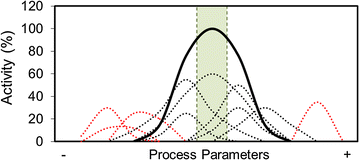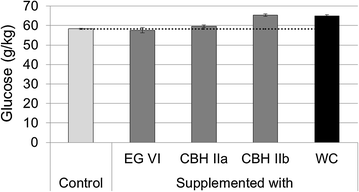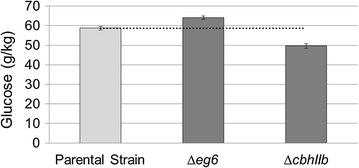Management of enzyme diversity in high-performance cellulolytic cocktails
- PMID: 28649275
- PMCID: PMC5477296
- DOI: 10.1186/s13068-017-0845-6
Management of enzyme diversity in high-performance cellulolytic cocktails
Abstract
Background: Modern biorefineries require enzymatic cocktails of improved efficiency to generate fermentable sugars from lignocellulosic biomass. Cellulolytic fungi, among other microorganisms, have demonstrated the highest potential in terms of enzymatic productivity, complexity and efficiency. On the other hand, under cellulolytic-inducing conditions, they often produce a considerable diversity of carbohydrate-active enzymes which allow them to adapt to changing environmental conditions. However, industrial conditions are fixed and adjusted to the optimum of the whole cocktail, resulting in underperformance of individual enzymes.
Results: One of these cellulolytic cocktails from Myceliophthora thermophila has been analyzed here by means of LC-MS/MS. Pure GH6 family members detected have been characterized, confirming previous studies, and added to whole cocktails to compare their contribution in the hydrolysis of industrial substrates. Finally, independent deletions of two GH6 family members, as an example of the enzymatic diversity management, led to the development of a strain producing a more efficient cellulolytic cocktail.
Conclusions: These data indicate that the deletion of noncontributive cellulases (here EG VI) can increase the cellulolytic efficiency of the cocktail, validating the management of cellulase diversity as a strategy to obtain improved fungal cellulolytic cocktails.
Keywords: Bioethanol; Cellulolytic cocktail improvement; Enzymatic hydrolysis; Lignocellulosic biomass.
Figures



Similar articles
-
Designing a cellulolytic enzyme cocktail for the efficient and economical conversion of lignocellulosic biomass to biofuels.Enzyme Microb Technol. 2020 Feb;133:109442. doi: 10.1016/j.enzmictec.2019.109442. Epub 2019 Oct 10. Enzyme Microb Technol. 2020. PMID: 31874688 Review.
-
Cellulase activity mapping of Trichoderma reesei cultivated in sugar mixtures under fed-batch conditions.Biotechnol Biofuels. 2013 May 17;6(1):79. doi: 10.1186/1754-6834-6-79. Biotechnol Biofuels. 2013. PMID: 23680258 Free PMC article.
-
Additives enhancing enzymatic hydrolysis of lignocellulosic biomass.Bioresour Technol. 2017 Nov;244(Pt 1):48-56. doi: 10.1016/j.biortech.2017.06.132. Epub 2017 Jun 26. Bioresour Technol. 2017. PMID: 28777990
-
Enzymatic Hydrolysis of Lignocellulosic Biomass Using an Optimized Enzymatic Cocktail Prepared from Secretomes of Filamentous Fungi Isolated from Amazonian Biodiversity.Appl Biochem Biotechnol. 2021 Dec;193(12):3915-3935. doi: 10.1007/s12010-021-03642-5. Epub 2021 Aug 19. Appl Biochem Biotechnol. 2021. PMID: 34410613
-
An update on enzymatic cocktails for lignocellulose breakdown.J Appl Microbiol. 2018 Sep;125(3):632-645. doi: 10.1111/jam.13923. Epub 2018 Jul 10. J Appl Microbiol. 2018. PMID: 29786939 Review.
Cited by
-
Cellulase production and efficient saccharification of biomass by a new mutant Trichoderma afroharzianum MEA-12.Biotechnol Biofuels. 2021 Nov 22;14(1):219. doi: 10.1186/s13068-021-02072-z. Biotechnol Biofuels. 2021. PMID: 34809676 Free PMC article.
-
Validation of leaf enzymes in the detergent and textile industries: launching of a new platform technology.Plant Biotechnol J. 2019 Jun;17(6):1167-1182. doi: 10.1111/pbi.13122. Epub 2019 Apr 23. Plant Biotechnol J. 2019. PMID: 30963679 Free PMC article.
-
Rio Tinto as a niche for acidophilus enzymes of industrial relevance.Microb Biotechnol. 2023 May;16(5):1069-1086. doi: 10.1111/1751-7915.14192. Epub 2023 Feb 7. Microb Biotechnol. 2023. PMID: 36748404 Free PMC article.
-
The Linker Region Promotes Activity and Binding Efficiency of Modular LPMO towards Polymeric Substrate.Microbiol Spectr. 2022 Feb 23;10(1):e0269721. doi: 10.1128/spectrum.02697-21. Epub 2022 Jan 26. Microbiol Spectr. 2022. PMID: 35080440 Free PMC article.
-
Enzyme Synergy in Transient Clusters of Endo- and Exocellulase Enables a Multilayer Mode of Processive Depolymerization of Cellulose.ACS Catal. 2022 Sep 2;12(17):10984-10994. doi: 10.1021/acscatal.2c02377. Epub 2022 Aug 24. ACS Catal. 2022. PMID: 36082050 Free PMC article.
References
-
- Nieves RA, Ehrman CI, Adney WS, Elander RT, Himmel ME. Technical communication: survey and analysis of commercial cellulase preparation suitable for biomass conversion to ethanol. World J Microbiol Biotechnol. 1998;14:301–304. doi: 10.1023/A:1008871205580. - DOI
LinkOut - more resources
Full Text Sources
Other Literature Sources

